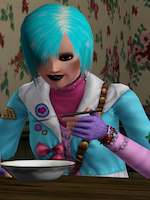Post by Janine@SPCC on Sept 10, 2012 6:55:32 GMT -5
Horse Genetics list and the correct variation
A) A, a, A+, At: Agouti
The dominant form is A, which, if present in a horse, restricts black to the points. In other words, it keeps black from the body parts, resulting in a bay or other color with black legs, mane and tail. The recessive or 'off' form is a-- it does not affect the black in any way; the horse may have black on entire body.
There may be other alleles for Agouti, too: A+ makes the horse a wild (primitive) bay, and At removes light pigment from soft body parts.
Cr) Cr, cr: Cream gene
When two cr genes are present, the horse is not a dilute (palomino, buckskin or the like). When one Cr gene is present, then the body is diluted (bay to buckskin, chestnut to palomino, etc.). When two Cr genes are present, then the horse is what is called a 'double dilute': a Cremello or a Perlino (lighter versions of the Palomino and Buckskin, respectively), or Smoky cream (black double dilute)
Ch) Ch, ch: Champagne
The Champagne gene, Ch, dilutes the color of the horse and also effects eye and skin color, as well as actual hair build. Horses with the Ch gene will be silvery-chocolate, reddish, or golden in color with a metallic sheen. Their eyes are amber, and their skin is a pink color, though not the pink of most horses-- it's a mottled orangey-pink. The hairs of a champagne are actually hollow, so this gene somehow affects more than color alone. ch is the regular gene, it has no affect.
D) D, d: Dun
The D gene creates a dun horse. It causes pigment to concentrate on one side of the hair, making it a diluted color. It also gives the horse a dorsal stripe, leg barring, and sometimes other primitive marks. A dun horse is either Dd or DD-- by just looking at that animal you cannot tell which. d is the regular allele, no effect.
E) E, e: Extension (black pigment)
The E gene creates black pigmentation; horse may be either EE or Ee. An ee horse will not have any black pigment (chestnut, red roan, palomino, etc.). A horse that is EE or Ee will have black pigment (black, buckskin, grulla, etc).
F) F, f: Flaxen
F creates a flaxen mane and tail, and perhaps lightens the body a bit, in ee horses.
G) G, g: Gray
G is the most dominant gene, and turns any color to gray. Foals may be born any color, but lighten with age. In other words, G is epistatic to all other genes. g has no effect.
Lp) Lp, lp: Leopard-complex
Lp creates mottling and spotting characteristics, and allows for different spotting patterns, such as those seen in the Appaloosa. lp has no effect.
N) N, n: White markings
One hypothesis is that the N gene prevents all white markings-- even if the horse had sabino or other pinto genes, this would mask them. n allows white markings to occur, and they will if pinto genes are present. It is not known for sure if the N gene exists.
Fr) Fr, fr: Frame
Fr creates the Frame pinto pattern in the horse. Homozygous form (FrFr) is lethal, resulting in an OLWS (overo lethal white syndrome) animal that dies.
P) P, p: Pangare
The Pangare gene, P, lightens the horse's muzzle, flanks and belly, creating a 'mealy' horse.
Rn) Rn, rn: Roan
Creates a mix of light and dark hairs, making roaning.
Sb) Sb, sb: Sabino
The genetic control of sabino is not completely known. It appears to be polygenic, and not a simple dominant like tobiano.
Sc) Sc, sc: Snowcap
Causes pigment loss in the form of snowcap spotting, in the presence of Lp.
Sd) Sd, sd: Dark spots
Causes dark spots in the presence of Lp.
Sn) Sn, sn: Snowflake
Causes white spots (snowflake pattern) in the presence of Lp.
Sv) Sv, sv: Varnish
Causes silvering/varnish effect in the presence of Lp.
Spl) Spl, spl: Splashed White
Causes pigment loss in the form of a Splashed White patterned pinto.
Sty) sty, Sty: Sooty
Causes mixture of black hairs, creating seasonal dapples, or a 'sooty' appearance.
To) To, to: Tobiano
Causes pigment loss in the form of a tobiano pinto pattern.
W) W, w: White
Causes pigment loss over entire body in hair and skin, but not eyes; dominant white. There is some doubt as to whether this gene actually exists.
Z) Z, z: Silver
Dilutes black pigment, has no effect on red pigment.
Let us start off with the correct coats and names and examples of them.
GREY
Many people see a horse like the one pictured at left and assume he is white. He is, however, a grey. Grey is a gene that modifies a horse's coat color, no matter what it is, and causes it to de-pigment with age, much like human hair changes color as we age, whether we're blond, brunette, or red-headed. All grey horses are likewise born "dark," be it black, chestnut, bay appaloosa, or palomino. As they age, their coat changes, often going through a dappled phase which is usually quite lovely. Some grey horses will never turn entirely "white," retaining traces of color in their manes and tails or on their knees and hocks. Some even develop little flecks of color throughout their coats, known as flea-bitten grey. But most importantly, no matter how greyed-out they are, grey horses are genetically grey, never white.

Creme Gene
Another color frequently confused as being white or albino is cremello. This color is the result of two cream genes, one from each parent, acting on a chestnut base coat. The cream gene is an incomplete dominant, meaning that two copies of the gene will dilute the coat color more than just one. One cream gene combined with chestnut will dilute the coat to create palomino. Two creams genes dilute the coat to cremello, a very pale, golden shade often mistaken for white. Cremellos always have blue eyes which can lead to confusion with albino, a color that simply doesn't exist in any horse breed. True albinism is a recessive condition characterized by red-eyes, pink skin, and a total lack of dark pigment. Cremellos do still have some pale golden pigment to their coats and skin as well as blue pigment in the eyes.
There's NO such thing as an albino horse!
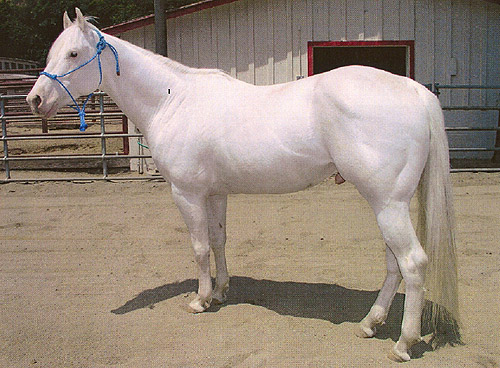
Dominant White
The idea of a dominant white gene has fallen in and out of favor among students of equine color genetics over the years, and until very recently, it was assumed to be a variation of the sabino pattern. (Sabino appears to be polygenic, and more than one complex of (likely related) genes can produce a sabino-type pattern. Extreme sabinos, all-white horses, are believed to be homozygous.) No evidence could be found of all-white horses that produced like-colored offspring, only those that produced a mix of white, white-patterned, and even solid foals.
As I've explained above, there is not one single, simple gene at work creating "white" horses nor are there true albino horses. They are the result of several unrelated genes, from cream to pinto. There is, however, something known as lethal white overo that can cause some confusion.
Here is a list of certain breeds and their coats requirements:
Arabians: black, chestnut, bay, brown, and grey. Patterns include sabino and rabicano. True dark-headed roan does not exist in the breed. What they call "roan" is actually a rosy shade of grey that bay or chestnut horses go through when they grey out. There are also a handful of purported palomino and buckskin Arabs, but the cream gene doesn't exist in the gene pool, so those horses are really only light chestnuts (with enhanced flaxen manes and tails) or bays.
Clydesdales: black and bay. Patterns include sabino. Most, if not all, Clydesdales carry the sabino pattern to some degree. Some extremely marked individuals have been confused with roans, but true dark-headed roan does not exist in the breed. Grey is also not found in the breed, though many extremely marked black sabinos are confused with greys. Supposedly, chestnut can be found in the breed (and it does figure logically), but I've never seen photographic evidence of it.
Friesians: black and chestnut. Friesians are predominantly homozygous black, but a handful of individuals are heterozygous, meaning they carry one black gene and one chestnut. Occasionally, two heterozygous individuals are bred, and a chestnut foal is produced. It is very rare, however, and only four chestnuts are currently known. Friesians were also known to have come in grey, but none exist now.
Morgans: black, chestnut, bay, brown, grey, all cream dilutions, all dun dilutions, roan, and silver dapple. Patterns include frame overo, sabino, and rabicano. The sabino pattern can cause unusual roan-looking horses that seem to be unique to the Morgan breed. They are roaned all over, including their heads and legs, so they are not true dark-headed roans. That said, true, dark-headed roans do exist in the breed though they are incredibly rare.
Quarter Horses: black, chestnut, bay, brown, grey, all cream dilutions, all dun dilutions, roan, silver dapple, pearl, and champagne. Patterns include frame overo and sabino. Single dilute creams (palomino, buckskin, and smoky black) have always been accepted. Frame overo and sabino, from minimum to maximum expression, are responsible for the "crop out Paints" seen in the breed.
Paint: black, chestnut, bay, brown, grey, all cream dilutions, all dun dilutions, roan, silver dapple, pearl, and champagne. Patterns include tobiano, frame overo, tovero, splash white, and sabino. Any color goes so long as the horse is patterned.
Saddlebreds: black, chestnut, bay, brown, grey, all cream dilutions, silver dapple, roan, and champagne. Patterns include tobiano, frame overo, tovero, sabino, and rabicano. True dark-headed roans are exceedingly rare, but a few do still exist.
Standardbreds: black, chestnut, bay, brown, grey, all cream dilutions, abd roan. Patterns include tobiano, sabino, and rabicano. True dark-headed roans and cream dilutes are rare, but a few do still exist.
Thoroughbreds: black, chestnut, bay, brown, grey, and all cream dilutions. Patterns include sabino, frame overo, and rabicano. As with Arabians, the Jockey Club still lists roan as a color, but true dark-headed roan does not exist in the breed. What they call "roan" is actually a rosy shade of grey that bay or black horses go through when they grey out.
Appaloosa
The wild spotting pattern typified by the Appaloosa breed is caused by a group of genes called the leopard complex (Lp). The pattern can be manifested in several ways: varnish, blanket, leopard, snowcap, and few spot. Horses who are heterozygous (Lplp) for the leopard complex will exhibit the varnish, blanket, or leopard patterns. Horses who are homozygous (LpLp) for the leopard complex will exhibit the snowcap or few spot patterns. According to recent studies, the appaloosa pattern in it's heterozygous state seems to manifest itself similarly to the pinto genes. Moderately expressed appies will have a small blanket, more boldly marked horses will have larger blankets, and the most boldly patterned horses are entirely covered by the blanket, meaning they are leopard appaloosas. Appaloosa pattered horses also have distinct markings besides their spots---they have striped hooves, mottled skin, and white sclera.
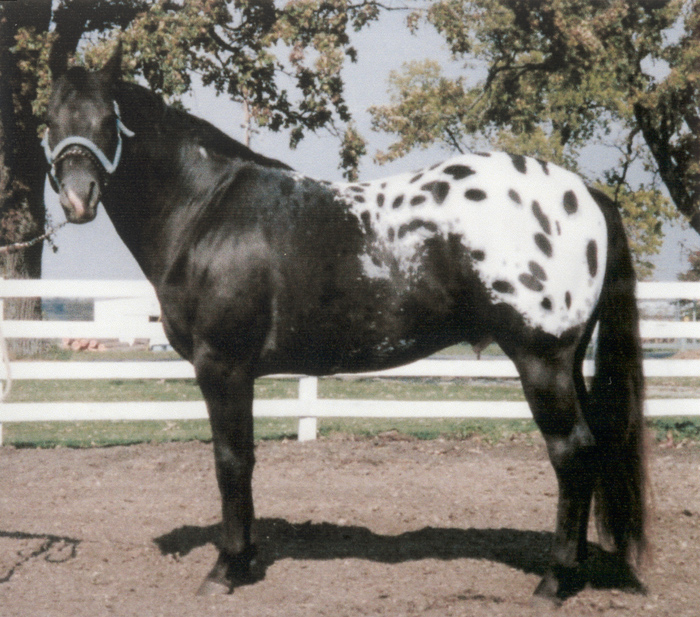
Pinto Patterns
Pinto Patterns: Pinto is a term that refers to several different patterns of white. The patterns fall into two catagories, tobianos and overos. The overo catagory is really just a catch-all for non-tobiano patterns that includes frame overo, sabino, dominant white, and splash white. A horse with a combination of tobiano and one or more overo patterns is known as a tovero.
The tobiano pattern is dominant, and it is characterized by white crossing the horse's back between the withers and the dock, as well as by areas of color on the head, chest, and flanks. Most tobianos have normal face markings like stars and blazes, and they almost always have four white feet. The most minimally marked tobianos occasionally appear to have only 4 stockings and no other discernable white markings.
Splash white horses look as if they've literally been splashed with white paint from the underside or dipped in white paint. Splash white is an incomplete dominant. Homozygous spashes will have more white than heterozygous splashes. Splash markings tend to have smooth, crisp edges, and most splashes have blue eyes (especially the homozygous ones).
Most pinto patterns can range from minimal expressions (a nearly solid colored horse) to extreme expression (an all-white or nearly all-white horse). White horses resulting from tovero and sabino patterns are completely viable. White horses that are homozygous for frame overo, however, are known as lethal white overos (LWO).
The tobiano pattern is dominant, and it is characterized by white crossing the horse's back between the withers and the dock, as well as by areas of color on the head, chest, and flanks. Most tobianos have normal face markings like stars and blazes, and they almost always have four white feet. The most minimally marked tobianos occasionally appear to have only 4 stockings and no other discernable white markings.
Splash white horses look as if they've literally been splashed with white paint from the underside or dipped in white paint. Splash white is an incomplete dominant. Homozygous spashes will have more white than heterozygous splashes. Splash markings tend to have smooth, crisp edges, and most splashes have blue eyes (especially the homozygous ones).
Most pinto patterns can range from minimal expressions (a nearly solid colored horse) to extreme expression (an all-white or nearly all-white horse). White horses resulting from tovero and sabino patterns are completely viable. White horses that are homozygous for frame overo, however, are known as lethal white overos (LWO).
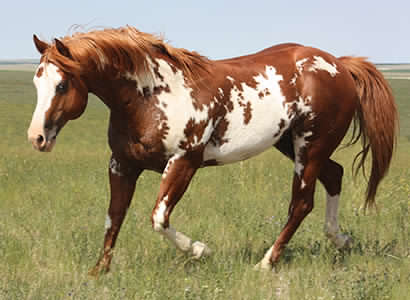

Chestnuts
Chestnuts vary in shade in from a light golden red color to coppery red to dark liver. Some of the darkest liver chestnuts, often called "black chestnuts," are nearly indistinguishable from true black horses. Some chestnuts have have flaxen manes and tails.
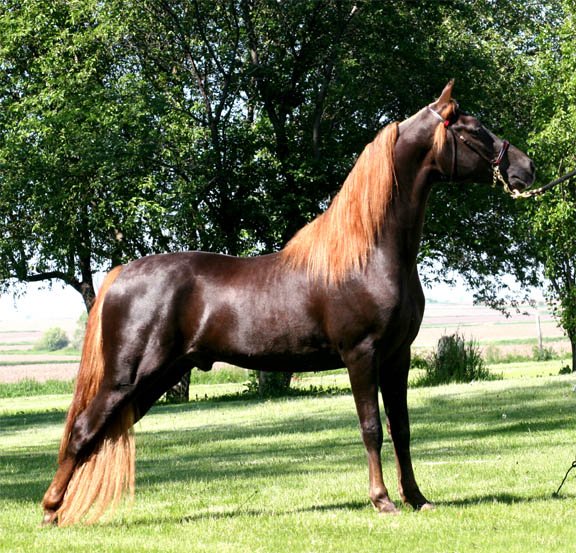

All horse colors are built on only two base colors, black (E) and chestnut (e). Black is dominant to chestnut, and chestnut is thus recessive. That means that a horse carrying 2 black genes (EE) will be (homozygous) black; a horse carrying one black gene and one chestnut gene (Ee) will also be black (but heterozygous); and a horse carrying two chestnut genes (ee) will be chestnut (always homozygous). So if two heterozygous black horses are bred together (Ee +Ee), they have 1 chance in 4 of producing a homozygous black (EE), 2 chances in 4 of producing a heterozygous black (Ee), and 1 chance in 4 of producing a chestnut. Pretty neat, huh? Two chestnuts bred together (ee + ee) can only produce chestnut.
Black
Black horses can also vary in shade---from blue-black to dusty black to sun-faded black. Not all black horses fade in the sun, but those that do generally resemble brown, dark bay, or even liver chestnut horses. The ends of their manes and tails often fade to a burnt reddish shade.
A true black like Lonhro will not show any brown hairs on the muzzle, the telltale sign of the presence of the agouti gene.

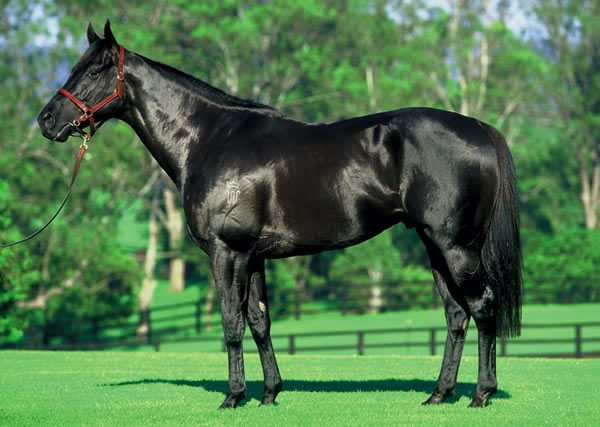
A true non fading black is a very recessive gene and therefore foals will not turn out black nor fade into black.*unless bred with another true black*

